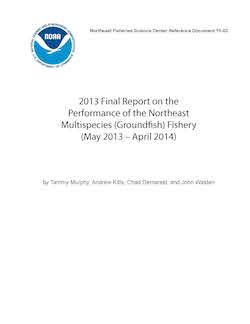Folks here in Maine are still digging out from this week's blizzard. When you get upwards of 27 inches of snow, it takes awhile to clear roads, parking lots, driveways, porches and stairs. It took me nearly three hours just to shovel out enough space to get all our cars off the street and into the driveway before the plow trucks got to work in earnest.
Northeast fishermen have for many years been doing some digging of their own. But digging out from the troubles that continue to plague the groundfish industry has been far more difficult clearing snow from driveways.
 The report on the economic performance of the Northeast groundfish fishery shows continued declines in landings, ex-vessel prices, revenues and fleet size. NMFS photoFor more than two decades, lagging populations of some key groundfish species have driven Northeast groundfish management. You need look no further than the just released annual report on the economic performance of the Northeast groundfish fishery to see the toll that increasingly stringent regulations designed to rebuild those species has taken on fishery.
The report on the economic performance of the Northeast groundfish fishery shows continued declines in landings, ex-vessel prices, revenues and fleet size. NMFS photoFor more than two decades, lagging populations of some key groundfish species have driven Northeast groundfish management. You need look no further than the just released annual report on the economic performance of the Northeast groundfish fishery to see the toll that increasingly stringent regulations designed to rebuild those species has taken on fishery.
The report documents the fishery's performance in 2013. What it shows is that negative trends seen in 2012 continued in 2013.
According to the report, declining groundfish landings were coupled with little growth in non-groundfish landings in 2013. Total landings of all species decreased 1.6 percent from 260.5 million pounds in 2012 to 256.4 million pounds. And total groundfish landings dipped to a four-year low of 42.2 million pounds in 2013 versus 58.7 million pounds in 2010.
Moreover, average groundfish and average non-groundfish ex-vessel prices also hit a four-year low, despite the landings decline. In 2010 dollars, the average groundfish price per pound was $1.31 compared to $1.42 in 2010.
The landings and price changes brought total groundfish revenue to a four-year low of $55.2 million in 2013. Groundfish gross revenues totaled $83.2 million in 2010.
In 2010, the number of active vessels that took at least one groundfish trip was 446. That total fell 327 boats in 2013. Total crew positions dropped from 2,268 in 2010 to 2,039 in 2013. From 2012 to 2013, the report states, the fleet decreased by 28 vessels overall.
Chances are a year from now, the news on the fishery's 2014 performance won't be any rosier. Creating jobs and new fishing opportunities are among the immediate goals of NMFS's recently released five-year strategic plan for the region. If that is to happen, the agency is going need to do more than focus primarily on Magnuson-Stevens Act stock rebuilding guidelines.
The five-year plan seems to signify that NMFS may be more willing to work with fishermen than it has in the past. Putting it on paper is one thing, but truly committing to it is another. Only time will tell whether the strategic plan will bear fruit.







